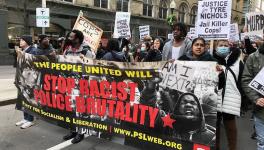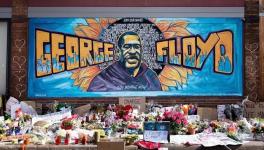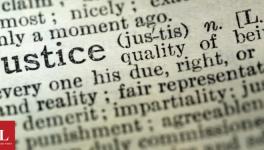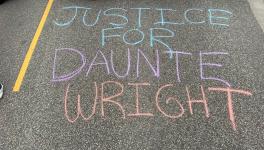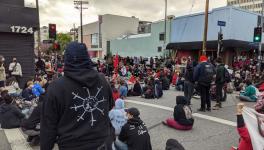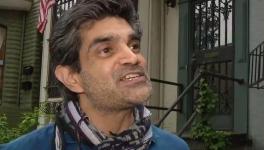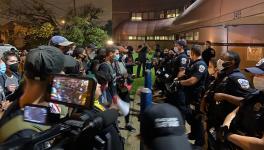One Year Since George Floyd’s Death and the Largest People’s Uprising in US History
Flowers and tributes placed in front of the Cup Foods in Minneapolis near where George Floyd was killed. Photo: Vasanth Rajkumar/Wikimedia Commons
George Floyd was suffocated to death by former police officer Derek Chauvin on May 25, after he was apprehended by a group of four officers in Minneapolis outside the Cup Foods store. The incident and the widely shared video of his death, reignited nationwide outrage against police violence and racism.
What followed was months of protests around the country, with long-standing demands ranging from defunding the police to demilitarization of the police to police abolition receiving national spotlight. After months of protests and prosecution, the prime accused in Floyd’s murder, Derek Chauvin, was eventually convicted last month, on April 20, by a local jury.
Today, on the first anniversary of his death, looking back at a year of people’s resistance, in what was possibly the largest uprising in US history, it is clear how the movement has given rise to new forms of solidarity and grassroots politics, not just in the US but around the world.
Minneapolis, the city where the tragic violence took place, turned into an epicenter as large scale protests spread across the US. In less than two weeks, over 550 locations in the US alone reported large demonstrations. According to a survey by Civis Analytics, by June 6 of 2020, anywhere between 15 million and 20 million people participated in demonstrations and protest rallies.
An estimated 40 percent of the counties in the US had regular protests throughout the month of June. Major cities like New York, Washington DC, Chicago, Denver, Portland, Oakland, Louisville, Denver, Atlanta, Detroit, Los Angeles, Houston, and Seattle, among others. Over the next few months, more than 5,000 locations witnessed protests.
These protests were also met with widespread and unhindered repression. In the first few weeks of protests more than 14,000 people were estimated to have been arrested by the police. At least 25 deaths were reported during the course of the protest, excluding instances of police violence outside the protests, and hundreds injured.
Thousands of National Guard troops were deployed in 30 states, the biggest domestic mobilization of federal troops during peacetime in US history, and hundreds of protesters ended up being charged under federal crimes.
Journalists were not spared either. Media groups and press freedom advocates have pointed out the disproportionately large scale of violence inflicted by the police on reporters at the site of protest. More than 200 cases of arrests and physical attacks on journalists were reported in the year 2020, as per a report by the Committee to Protect Journalists.
Along with George Floyd, the protests brought along demands of justice for the killings of others as well, including Breonna Taylor in Louisville, Jacob Blake in Kenosha, Rayshard Brooks in Atlanta, Marcellis Stinette and Adam Toledo in Chicago, Walter Wallace Jr. in Philadelphia, Daunte Wright in Minneapolis, and Deon Kay in Washington DC, among other cases.
Apart from Floyd’s case, where at least the person primarily responsible for his death was eventually found guilty, other families continue to wait for justice. Police officers and police departments have received little to no repercussions from governing bodies.
Armed with the slogans of the 2014 Black Lives Matter protests, which emerged in the context of a spate of reported racist police violence and killings beginning in 2012, new tactics of resistance emerged from such systemic failure. Police precincts around the country started facing the outrage of the people first-hand.
In the city of Seattle, Washington, for instance, people’s demonstration led to the city police forces being rendered ineffective in an entire block of the city for nearly a month. The protests also led to a massive push for structural changes in policing led by socialist councillor Kshama Sawant.
Similarly, in Minneapolis, the city council came the closest in the country towards dismantling the police department and replacing it with a community-run initiative for public safety. Despite the city council passing a veto-proof resolution to that end, the effort was only thwarted by a state-appointed charter council which indefinitely deferred a referendum on the resolution.
New cases of police violence are now very often met with spontaneous protests at police stations that have become the new site of resistance for the movement. Scrutiny has also begun to be put on police funding, which in metropolitan cities like New York, Chicago and Los Angeles, goes up to billions of dollars, despite a spate of budget cuts last year.
One of the most promising outcomes of the protests since Floyd’s death, is the revival of organizing among Black and other racially discriminated communities. Trade union leaders, who were part of the union drive of Amazon warehouse workers in Alabama, have often credited the movement for unionization as a direct result of a new wave of organizing among Black communities.
A large section of the low-income workers in the US are either Black or people hailing from other disadvantaged and oppressed minority groups. The participation of workers movements and trade unions on Juneteenth, with a nationwide Strike for Black Lives, was testament to how the struggles came together.
International solidarities were also built, as movements around the world in South Africa to Latin America to Palestine to Europe and more have found echoes of their struggles as they stood up against racism.
Having gone through the largest popular uprising since the Civil Rights Movement, it would be difficult for the US to continue to remain the same. As the nation and the world remembers George Floyd and the countless others who have fallen victim to police murders, the movement continues to march ahead.
Week of action
Families of George Floyd and other victims of police violence, along with activists across the US, have organized memorials and demonstrations across the United States, for the one-year anniversary of Floyd’s death. The series of events were launched on Sunday, May 22, with a march in Minneapolis. The march, organized by a non-profit George Floyd Memorial Foundation, based in Fayetteville, North Carolina where Floyd hails from, was the first in a series of events organized this week by civil society groupsPeoples Dispatch for the one year anniversary of Floyd’s death on Tuesday, May 25.
The Floyd family was joined in Minneapolis by other families of police violence victims and activists and members of the Floyd family participated in similar events in other cities. In Brooklyn, New York, George’s brother Terrence Floyd participated in a march. “If you keep my brother’s name ringing, you’re going to keep everybody else’s name ringing,” Terrence Floyd told the crowd. “Breonna Taylor, Sean Bell, Ahmaud Arbery, you could go through the whole list. There’s a lot of them.”
On Tuesday May 25, civil rights activists and allies across the country observed a “Day of Action” to reinforce their continuing struggle. Solidarity demonstrations were also planned by progressive movements in different countries around the world.
Courtesy: Peoples Dispatch
Get the latest reports & analysis with people's perspective on Protests, movements & deep analytical videos, discussions of the current affairs in your Telegram app. Subscribe to NewsClick's Telegram channel & get Real-Time updates on stories, as they get published on our website.









